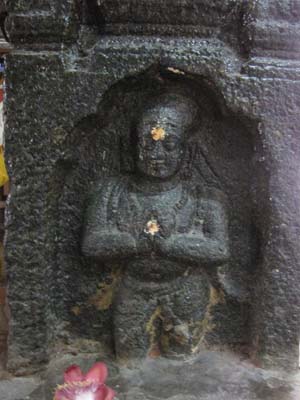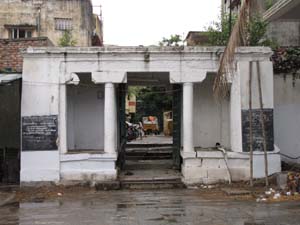|
It is easy to walk past it, unaware of its existance. Sans gopuram, sans flower-vendors and sans crowds inside, the Virupakshishwara Temple on busy Bazaar Road in Mylapore is one of the less known temples of Chennai. Interestingly, although people visiting the temple enter through the gateway on the west, the main entrance is on the south, via Virupakshishwarar Sannidhi Street, a small lane perpendicular to Karneeswarar Kovil Street. The main shrine faces east.
|

Half-buried sculpture of Sivanesa Chettiar-base of pillar-mantapa

Recently demolished entrance to Virupakshishvara temple, Mylapore
|
Those connected with the temple claim that the Linga enshrined here is the largest in the seven well-known Siva temples of Mylapore. Adjoining the main sanctum, there is a small mantapa which has pillars of delicate workmanship. On close observation you notice with delight that no two pillars of this hall are alike, and with dismay that the newly laid polished granite flooring has obscured most of the sculptures found at the base of the pillars. One of these carvings is believed to be that of Sivanesa Chettiar, who is fondly remembered by Mylaporeans as the father of Poompavai who was brought back to life by the renowned Saivite saint Tirugnanasambandar. This story is closely connected with the nearby Kapaleeswarar Temple.
The shrine of Goddess Vishalakshi, the consort of the presiding deity, faces south and can be entered through this mantapa. It is a surprise to notice that in front of the Goddess is a small stone image of Nandi, the vehicle of Siva, and not the lion, the mount of Goddess Parvati. This is indeed rare. While it is fairly easy to convince the layperson with interesting stories about unusual sculptures and out-of-the-ordinary events, not so is the case with the heritage buff!
There is a large tank inside the premises of the temple but, like many others in Chennai, it is badly maintained. Sporadic efforts at cleaning the tank have resulted only in short-term rewards. Tanks were excavated in the past inside or near temples, not only for carrying out ritualistic purposes, but also for utilitarian benefits. The temple tank helped harness rainwater and recharge groundwater levels. Unless and until local residents are made to understand the importance of a tank in the vicinity, sustained maintenance will indeed be a distant dream. In the case of the Virupakshishwara Temple, it is sad to see that in recent times, apartment complexes have sprouted almost by the very side of the tank.
There are many inscriptions etched in the ancient Tamil script found on the walls of the temple, starting from the Chola times of the 11th Century C.E. down to the 16th Century C.E. As in the case of many temples in Chennai and elsewhere, time and neglect have taken their toll of these ancient documents and most of them are in a damaged condition. Many of these are inscribed on the inner walls of the main sanctum sanctorum which houses the Siva Linga and, therefore, cannot be seen by visitors to the temple.
The earliest of these records belongs to the reign of Vira Rajendra Chola (1062/63-1070 C.E.) and, like the others, is donative in nature, registering a gift of two cows. There are two inscriptions of the 13th Century A.D. One belongs to the reign of the Pandyas and the other to the time of Kopperunjinga, a scion of the Pallavas and one of the most interesting personages in the annals of Tamil history. The only inscription that is clearly visible to visitors to the temple is etched above a pillar in the maha-mantapa. Although fragmentary, the words indicate gold donated to the temple for offerings of incense, flower-garlands and anointment of the deity for one year.
There are many who wonder how inscriptions of the time of Chola emperors, who ruled from Gangaikonda Cholapuram, and Pandya monarchs, whose centre of power was Madurai, find a place in temples in Chennai. It is clear from epigraphic and literary evidence that these rulers had conquered vast parts of South India and left behind their epigraphs on the temple walls of the areas they conquered. Moreover, many of these lithic records are not donations by the monarchs themselves, but by local people. While some are dated, the majority are not. It is only on the basis of the study of the script of the inscriptions that the date of the latter can be ascertained. Only trained epigraphists can do this. The sad part is there are hardly any takers for this branch of study these days.
A new gopuram is to be constructed at the entrance on the south. While many would argue against a brand new structure being built on the premises of an age-old temple, it would be good to remember that many of the hoary temples of Tamil Nadu are the result of centuries of evolution, with each successive dynasty contributing to its architectural growth. However, in this case, an ancient structure which served as the entrance has been pulled down to make way for this gopuram. While this too could be accepted as the correct procedure, considering the decrepit state it was in, what is worrisome is the loss of precious historical wealth in the process. There was a 12th Century inscription on the granite slab on the ground at this entrance. Although fragmentary and much worn-out, it served as an important reminder of the ancient treasures Mylapore still possesses.
It is sad indeed to see such authentic relics of our ancient past disappear in front of our eyes.
|